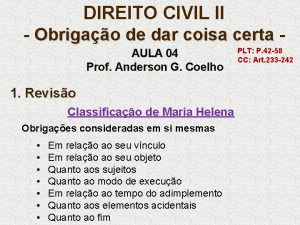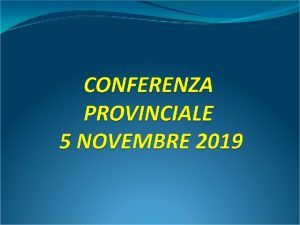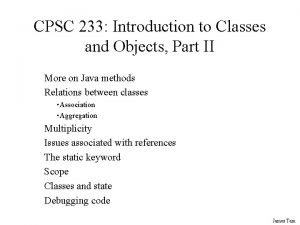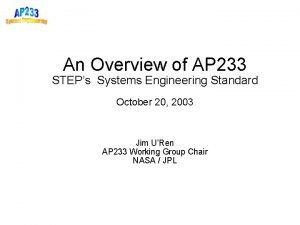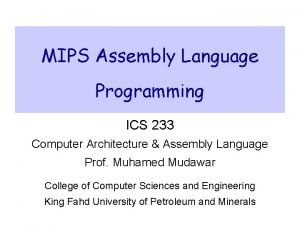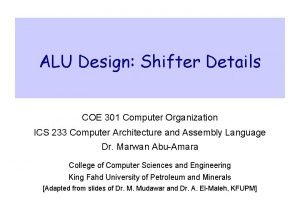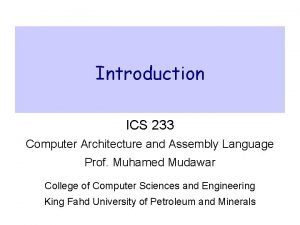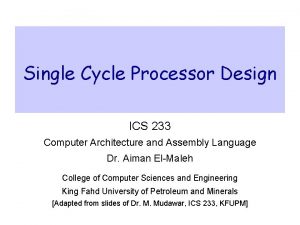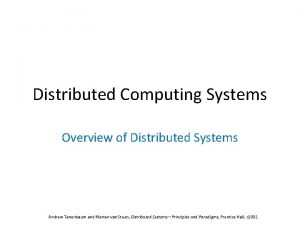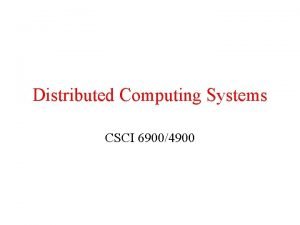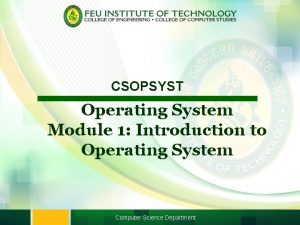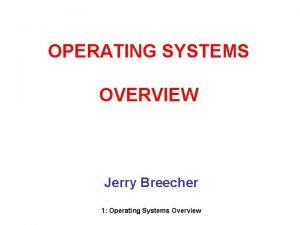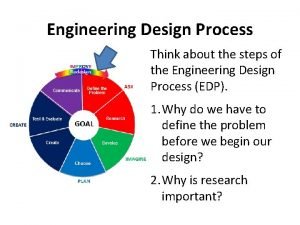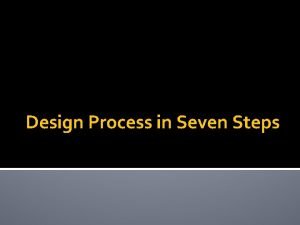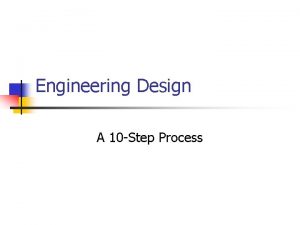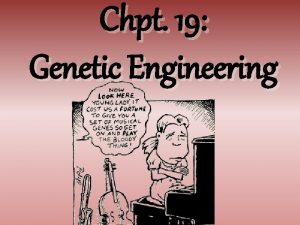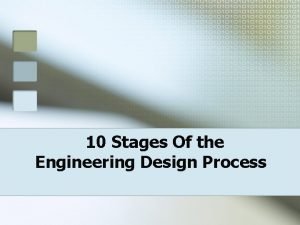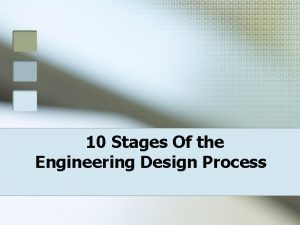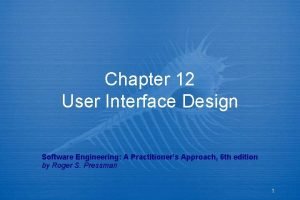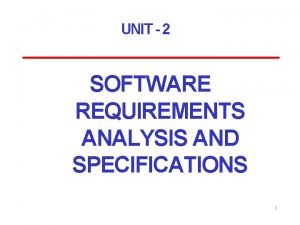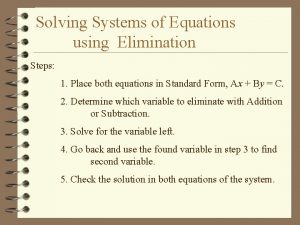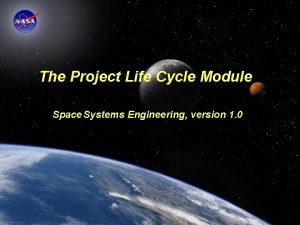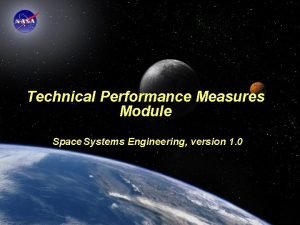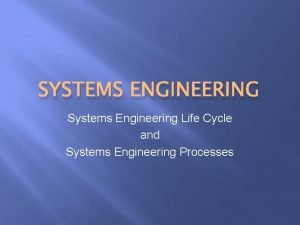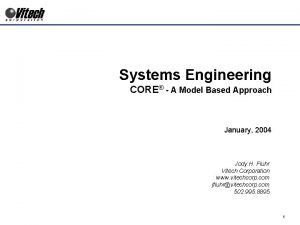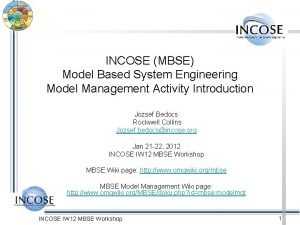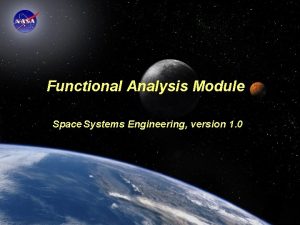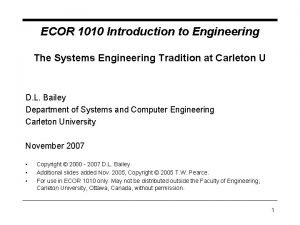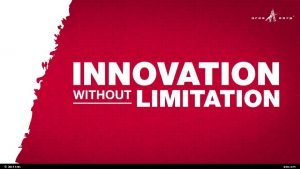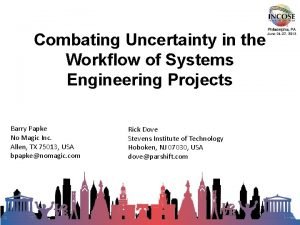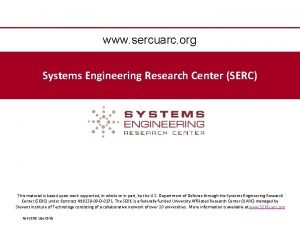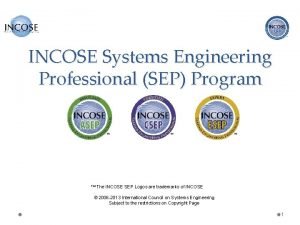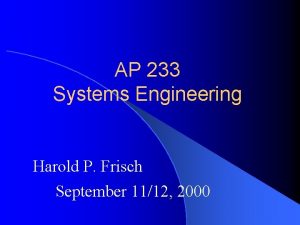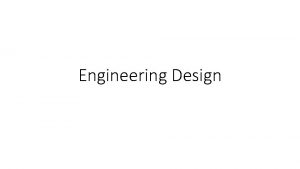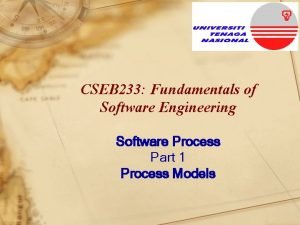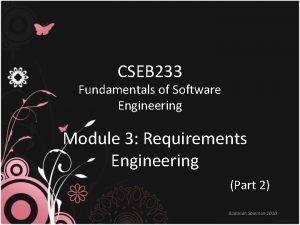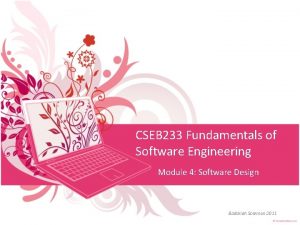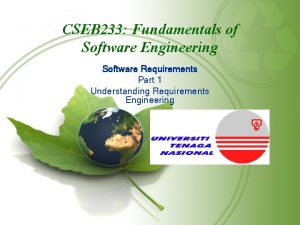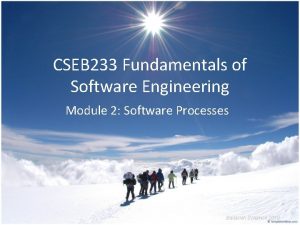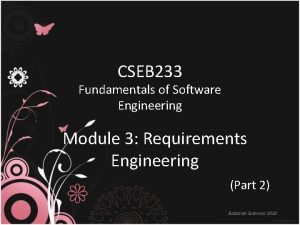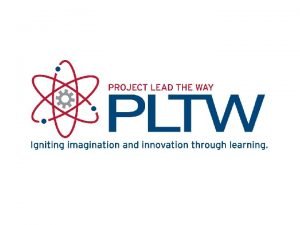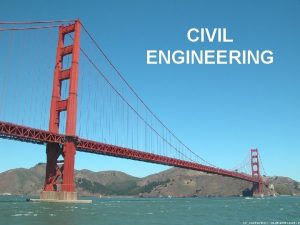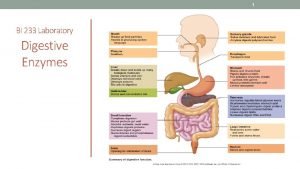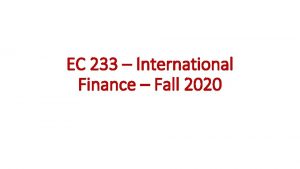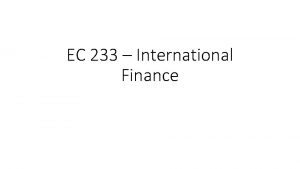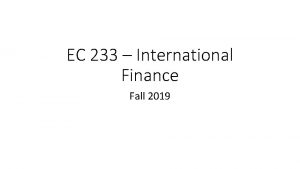An Overview of AP 233 STEPs Systems Engineering


















![[ Backup Slides ] [ Backup Slides ]](https://slidetodoc.com/presentation_image_h/e9d642da108b48968c0c272aa7a50f98/image-19.jpg)






























- Slides: 49

An Overview of AP 233 STEP’s Systems Engineering Standard October 20, 2003 Jim U’Ren AP 233 Working Group Chair NASA / JPL

What is AP 233 a STEP-based* data exchange standard targeted to support the needs of the systems engineering community, Parallels emerging standards in MCAD, ECAD, engineering analysis, PDM and product development domains. Provides neutral data models to exchange and integrate information between systems engineering tools * STEP – ISO 10303 (STandard for the Exchange of Product information

The SEDRES Project: The Roots of AP 233 (Systems Engineering Representation and Exchange Standardization) SEDRES Project consisted of European aerospace companies > Aerospatiale, Alenia, British Aerospace (now BAE Systems), DASA (now Daimler. Chrysler), SAAB Joint projects > Gripen > Eurofighter (EF 2000) Project focused on specific SE data exchanges SEDRES initiated NWI in TC 184/SC 4 in 1998 to provide a means of publishing its work Demonstrated that STEP could be used to exchange systems engineering information

Primary Driver: Reduction in Tool Interfaces AERO LABSYS ISI Matrix/X CAYENNE TEAMWORK AONIX St. P SES WORKBENCH NEUTRAL DATA EXCHANGE FORMAT i-LOGIX STATEMATE VERILOG SAO+ BAe CORE AERO LABSYS AONIX St. P ISI Matrix/X CAYENNE TEAMWORK SES WORKBENCH VERILOG SAO+ i-LOGIX STATEMATE BAe CORE

Current Approach of AP 233 Work Modularization > Avoids lengthy gestation of large AP efforts > Allows frequent, sequential deliveries > Provides on going evolutionary development environment Active Development Team > Bi-weekly Telecons > Web-based repository to collect, secure and publish work-in-progress > Public website Collaboration with existing Industry groups > INCOSE - International Council on Systems Engineering > OMG - Object Management Group / SE Working Group


Planned AP 233 Module Sets • Requirements • Structural Models • Behavioral Models • Validation and • • Verification Data Representation Risk Analysis • Analysis Interfaces • Scheduling • Cost Models • Organizational • • • Structure PDM Security Rules

This slide provides high level information about how STEP and other standards can be applied to the engineering domains that are part of the spacecraft development process. Fluid Dynamics • Standard: AP 237 • Status: In Development • Software - TBD • Orgs: Boeing, Ai. AA, NASA/Ames) Optics Standard: NODIF • Status: In Development • Software - TBD • Orgs: Minolta, Olympus, ORA • Structural Analysis Standard: AP 209 • Status: In Production • STEP in Spacecraft Development How the family of STEP Data Standards can be applied to Spacecraft Development Propulsion • Standard: STEP-PRP • Status: In Development • Software: TBD • Orgs: ESA, EADS Cabling & Wire Harness • Electro. Mechanical Assembly Standard: AP 210 • Status: Prototyped Pro. STEP, Bosch, Rockwell, Siemens • Software: Mentor Graphics, Eagle, Theorem Solutions, LKSoft, Zuken • Orgs: Rockwell, Boeing, NASA, Ga. Tech, CPES, ATI Software Engineering • Mechanical Engineering STEP AP 233 interface to UML is In Development • Software: Rational Rose, All-Together, Argo, Standard: AP 203 Ed. 1 & 2 , AP 214 • Status: In Production • Software Pro-E, Cadds, Solid. Works, • Rhapsody • Orgs: Lockheed, NASA, I-Logix, Auto. Cad, IDEAS, Catia, Unigraphics, Alibre, and others • Orgs: Industry-wide in aerospace and automotive industries (Europe & US) Systems Engineering • PDM STEP-TAS • • Software: Thermal Desktop, Thermica, De-emphasized boxes indicate data models ESARAD, TRASYS that are IN DEVELOPMENT. • Orgs: ESA/ESTEC, NASA (JPL & Langely) STEP-NC/AP 224, AP 238, and AP 2 xx (process plan) • • Status: : In Development / Prototyped • Software: : Gibbs, STEP-Tools, CAMsoft • Orgs: Honeywell, Boeing, GM, NASA-JPL JAU 2002 -10 -25 AP 233 / STEP-NRF RTM, Slate, Statemate, System Arch, Team. Work • Orgs: BAE SYSTEMS, EADS, NASA, CNES, Boeing, Lockheed, Raytheon, Vitech • Status: In Production • Standard: : Standard: • Status: In development / Prototyped • Software: Core, Doors, Mat. Lab, MS-Excel, Thermal Radiation Analysis Machining Standard: : UML • Status: In Production Industry-wide, a Desktop • Orgs: Lockheed Martin, Airbus, Boeing, NASA-Langely Standard: AP 212 • Software Mentor. Graphics • Orgs: Daimler-Chrysler, GM, Ford, ABB, • • Software: MSC Patran, Thermal • Standard: • Status: Prototyped / In production Inspection (Off-line) Standard: AP 219 • Status: In Development • • Software: Technomatics, Brown, e. Sharp • Orgs: NIST, DMIS, Boeing, Chrysler, AIAG Standard: STEP PDM Schema/AP 232 • Status: In Production • Software: Meta. Phase, Windchill, Insync, Matrix, Share-a-Space, STEP Book, STEP-Tools Inc. • Orgs: Lockheed Martin, EADS, BAE SYSTEMS, Raytheon, NASA. Boeing, Eurostep Life-Cycle Management • Standard: PLCS / AP 239 • Status: In Development • Software: PTC, LSC, AEI, Bonn • Orgs: BAE SYSTEMS, Boeing, Eurostep, NATO, UK Mo. D SLIDE_STEP-in-Spacecraft-Development-Ver 12 d. ppt

Mechanical and assembly design : AP 203 Documentation Structural Analysis : AP 209 Thermal Analysis : STEP-TAS Propulsion : STEP-PRP Mass & inertia Budgets (subset of AP 214) Optical Analysis : NODIF. . . Results of Analysis, Test & Operation Campaigns : STEP-NRF Space Technical Data Package : (AP 232) System Engineering : AP 233 AP-233 and the STEP architecture

Tools used in testing AP 233 Requirements Exchanges • Eurostep AP 233 • • Demonstrator Tool Telelogics DOORS Rational Requisite. Pro EDS SLATE Vitech CORE • LKSoft STEP Book • NIST Expresso • Eurostep SAS • MS Word • MS Excel • Poseidon UML

Requirements Initially Developed in DOORS

Export from DOORS to AP 233 Requirements Format

Requirements in AP 233 Demonstrator Tool

Requirements imported in Poseidon UML

Requirements imported from AP 233 into Vitech CORE

Export from EDS Slate to AP 233 Requirements Format

AP 233 Requirements Part 21 file (ARM based) Generated by Eurostep Demonstrator Tool ISO-10303 -21; HEADER; FILE_DESCRIPTION (('Ian Bailey'), '2; 1'); FILE_NAME ('C: \Program Files\Eurostep\AP 233 Demonstrator\Elevator. stp', '2003 -05 -07 T 14: 02: 48', (''), ('Ian Bailey'), 'ATBX V 1. 0 - AP 233_PBR_ALPHA 1 Toolbox Version 1. 0 (2002 -07 -02)', 'ATBX V 1. 0', 'C: \Program Files\Eurostep\AP 233 Demonstrator\Elevator. stp. log'); FILE_SCHEMA (('AP 233_PBR_ALPHA 1')); ENDSEC; DATA; #1 = PRODUCT_CATEGORY ('requirement', 'a required property or functionality'); #2 = PRODUCT_CATEGORY ('system', 'An assembly of interacting, active components or elements forming a whole'); #3 = VIEW_DEFINITION_CONTEXT ('Systems Engineering View', $, 'System Design Stage'); #4 = REPRESENTATION_CONTEXT ('Sys. Eng', 'Systems Engineering'); #8 = PRODUCT_CATEGORY_ASSIGNMENT (#2, (#5)); #12 = PRODUCT_CATEGORY_ASSIGNMENT (#1, (#9)); #36 = PRODUCT_CATEGORY_ASSIGNMENT (#1, (#33)); #46 = PRODUCT_CATEGORY_ASSIGNMENT (#1, (#43)); #56 = PRODUCT_CATEGORY_ASSIGNMENT (#1, (#53)); #70 = PRODUCT_CATEGORY_ASSIGNMENT (#1, (#67)); #79 = PRODUCT_CATEGORY_ASSIGNMENT (#1, (#76)); #90 = PRODUCT_CATEGORY_ASSIGNMENT (#1, (#87)); #135 = SYSTEM_DESIGN ((#3), #134, '', 'MP 1 v 1. 0 view 1', #3, 'MP 1 v 1. 0 view 1', . F. ); #134 = SYSTEM_VERSION ('1. 0', 'version 1. 0 of MP 1', #133); #133 = SYSTEM ('Description for Maintenance panel', 'MP 1', 'Maintenance panel'); #140 = SYSTEM_DESIGN ((#3), #139, '', 'DT 1 v 1. 0 view 1', #3, 'DT 1 v 1. 0 view 1', . F. ); #139 = SYSTEM_VERSION ('1. 0', 'version 1. 0 of DT 1', #138); #138 = SYSTEM ('Description for Diagnostic tool', 'DT 1', 'Diagnostic tool'); #161 = PRODUCT_CATEGORY_ASSIGNMENT (#2, (#158)); #142 = SYSTEM_ASSEMBLY_RELATIONSHIP ($, 'Diagnostic tool', #140, #125, 'System Assembly', $, $, $); #137 = SYSTEM_ASSEMBLY_RELATIONSHIP ($, 'Maintenance panel', #135, #125, 'System Assembly', $, $, $); #9 = REQUIREMENT ('High reliability', 'R 1', 'Reliabiity'); #33 = REQUIREMENT ('Lift 200 people', 'R 2', 'Lift capability'); #43 = REQUIREMENT ('Maximum number of passengers', 'R 3', 'Maximum passenger load'); #53 = REQUIREMENT ('Maximum weight', 'R 4', 'Maximum weight'); #67 = REQUIREMENT ('Speed requirements', 'R 5', 'Speed'); #5 = SYSTEM ('A state-of-the-art elevator', 'EV 1', 'Elevator'); #6 = SYSTEM_VERSION ('1. 0', 'version 1. 0 of EV 1', #5); #7 = SYSTEM_DESIGN ((#3), #6, '', 'EV 1 v 1. 0 view 1', #3, 'EV 1 v 1. 0 view 1', . F. );

Where do we go from here? • • continue to pursue sponsorship • • continue collaboration between with US agencies and organizations with European organizations OMG SE DSIG, INCOSE MDSD and STEP AP 233 teams extend areas of collaborative work through the PDES Inc consortium •
![Backup Slides [ Backup Slides ]](https://slidetodoc.com/presentation_image_h/e9d642da108b48968c0c272aa7a50f98/image-19.jpg)
[ Backup Slides ]


SYSTEM ENGINEERING PROCESS (this example from IEEE 1220) Customer's Requirements analysis Requirements trade studies Requirements Baseline validation System Functional trade studies Functional analysis Functional Verification Analysis Design trade studies Synthesis Physical Verification Control Sub-System specifications

The situation… Data Exchanges in context Development life-cycle phases Fundamental Data exchanges Customer Conception Creation Pre-system System definition Sub-System definition System-level Design Subsystem-level Design Fabrication, Assembly & Integration Test & Evaluation Prime Contractor / Partners Sub-contractor / Suppliers

SE Process and SE Tools Requirements analysis DOORS CORE SLATE RDD 100 Functional Analysis Synthesis RDD 100 Teamwork St. P Foresight Modline Workbench Statemate ELSIR RDD 100 Modarch Workbench OPNET Physical verification RDD 100 Modsim III Workbench BONES

From isolation to inter-working The Future The Past tool A tool B 1 checks x, y, z 2 checker/ viewer The consequences: Reduced benefits from each tool; Costs migrating to new tools/versions; Lack of an ‘integrated’ design dataset; Compromised success of partnerships 3 views a, b, c 4 The benefits: Reduced costs to transfer & check data (1, 3); Better achieve a coherent design (3, 4); Facilitate Integrated Product Development (1, 3, 4); Facilitate documentation/ design data management (2, 4)

Requirements for a system engineering exchange standard Shall be compliant with SE processes > > Support for primary, support & organisational processes From requirement elicitation to V&V Consistent with concepts of SEMP Through life cycle support Shall provide a tool independent representation Shall be compatible with industrial organisation Shall be implementable / adoptable by vendors Lead to a consequential reduction in number / variety of design tool interfaces

Requirements: Process compatibility

Requirements: Process - view points Requirement point of view Functional structure point of view Physical structure & allocation point of view Configuration and traceability point of view Project & data management point of view

Requirements: Process - Requirements Requirements, categories and structure System context & operational modes System environment description Validation & verification information Implementation verification Requirement trade study information Links to: > maturity, design phases, project control, project organisation, documentation support

Requirements: Process - Functionality Functional elements and child-parent hierarchy Requirement allocation Function inputs and function outputs Data description Behaviour description > possible modelling paradigms: state machines, time lines, structured text, logic tables, mathematical, analytical. . Links to: > maturity, design phases, project control, project organisation, documentation support

Requirements: Process - Physical structure Component description Subsystem hierarchy definition Data links / Physical interface definition Information interface definition Performance allocation Function allocation Support for validation, verification, traceability Links to: > maturity, design phases, project control, project organisation, documentation support

Requirements: Process - Configuration and traceability Item identification and version control Analysis iteration control with link to version Traceability management (upward / backward) Justification traceability Security management Link to full product management (consistency between real product and architectures) Trade-off & Justification support Exchange control

Requirements: Process - Project & data management Design process > Support for work breakdown structure > Support for a flexible process representation Partner organisation, stakeholders Design product packaging Work allocation

Requirements: Tool independence Shall provide a tool independent representation ==> > > > Neutral format data exchanges Neutral modelling paradigms Flexible item representation and description Extendibility Long term design-data storage Compatibility with several technology platforms • Upward compatibility with new enabling technologies (distributed environments, distributed repositories…) • Backward compatibility with simple exchange techniques

Requirements: Organisation Shall be compatible with industrial organisations ==> > Compatibility with industrial adopted technologies for data sharing & exchange > Support for organisation description and work allocation > User oriented / Usable > Supports both high / low data volumes; ‘deltas’ > Supports data exchange management > Compatibility with other techniques used in industrial domains (CAD systems…) > Extensible - evolving processes / data types

Requirements: Vendor acceptance Shall be implementable / adoptable by vendors ==> > > > Shown to be implementable Feasible to support (effort / cost / ROI) Tool neutral / vendor independent Based on mature data exchange technology Widely supported by tools & consultancy Widely supported by tool market users

Interface development process Process model (AAM) Exchange standard Encoding formats Information model (ARM) File + Reusable parts (STEP Libraries IR, AIC, Modules. . ) + Information model (AIM) STEP Tools Database SE Tool STEP Interface

Example design encoding (Part 21) Pilot pilot inputs Handle Head Down Display Avionics Systems system inputs Displays display attributes DATA; #1000=INTERNAL(‘Handle Head Down Display’, $, (#1004, #1005), (#1006), ‘Calculate display attributes from Pilot selections and system inputs’); #1001=EXTERNAL(‘Pilot’, ‘Aircraft pilot or navigator’, (), (#1004)); #1002=EXTERNAL(‘Avionics Systems’, $, (), (#1005)); #1003=EXTERNAL(‘Displays’, ‘Cockpit displays’, (#1006), ()); #1004=FLOW(‘pilot inputs’); #1005=FLOW(‘system inputs’); #1006=FLOW(‘display attributes’); END_DATA;

AP 233 Basic Philosophy & design principles Focussed on semantic level information > Graphics Unit of Functionality (Uo. F) is the exception Aspects of data model driven from principles > Distinction between Instances and Definition > Concept to support ‘re-use’ Aspects driven by ease of model evolution > Relationship entities > Support of templates for textual descriptions Model not tool-specific

Requirement Uo. F (1) Related to Requirement elicitation phase Defines several kind of requirements > > Functional requirements Constraints Physical requirements Operational requirements Other categories can be added from > ECSS 10 A > EIA 632. . .

Requirement Uo. F (2) Supports operational scenario definition Supports Derived requirements & composition relationship Defines the link between external entities and the system to be engineered > Externals / functional context Concept of Traceability matrices support > To functional breakdown structure > To physical breakdown structure

Functional Uo. F (1) Not linked to a particular engineering methodology > SART style > RDD style > In-house. . . 2 Behaviour When ? Functions 3 1 Data What ? How ?

Functional Uo. F (2) Supports the functional breakdown structure > Functions, instance & definition > Hierarchical relationships > Flows • Flow groups • Stores Data description > Data structure > Data types Links to Behavioural model > Causal chain, Finite state machine, synchronous

Behaviour Uo. F Finite state machines (State chart style) > > > State, instance & definition State hierarchies Transition Action on transition Events Control of functions Causal chains for safety critical systems Synchronous model (Clock driven behaviour)

Physical Uo. F Component definition and breakdown structure > Product Breakdown Structure (PBS) > Bill of Materials (BOM) Physical path description Functional/physical mapping ��Function ��Flows <=> �<=> Physical component Physical links

Graphics Uo. F Objective: > ensure (where applicable) that designs on receiving tool can bear ‘similarity’ in layout to original Visual Elements > Nodes, links that appear on SE diagrams > Association to semantic elements > Graphics points (nodes, link path) for diagram layout Is this the most appropriate approach?

System configuration management Uo. F (1) Configuration Management Item & Item Id Traceability matrices support > From requirements through to physical components Documentation support (‘Package’) Support for version control > > release / approval versions variants workspace revision

System configuration management Uo. F (2) Support for justification and maturity indices Relationships to process > work breakdown, activities & products Support for industrial schema > > “Who does what and where” Project Company Id Person Id Convergence with STEP Product Data Mgmt (PDM) Schema

STEP Interface usage w. r. t SE Tools SE Tool STEP Interface Tool API Neutral data Part 21 File Semantic mapping “SDAI” Part 22 Raw Database SE Tool Data Format Information models STEP Tool Neutral Data Format Semantic mapping

Test & Evaluation: ‘the bottom line’ Actual measurements of limited exchanges capture how time spent Simple analysis indicates projected times Note several activities currently due to prototype technology: > > Produce Part 21 file. . Manage & transfer. . Prepare for import. . are likely to go to zero in industrial implementation
 Principles of complex systems for systems engineering
Principles of complex systems for systems engineering Engineering elegant systems: theory of systems engineering
Engineering elegant systems: theory of systems engineering Hino 233
Hino 233 Art 233 cc
Art 233 cc Art 233 cc
Art 233 cc Dpr 233/98
Dpr 233/98 Cpsc 233
Cpsc 233 Ap-233
Ap-233 Ics 233
Ics 233 Mism-233
Mism-233 Alu shifter
Alu shifter Mudawar kfupm
Mudawar kfupm Site:slidetodoc.com
Site:slidetodoc.com Livoo tes 233
Livoo tes 233 Ics 233
Ics 233 233 general patton ave mandeville la
233 general patton ave mandeville la Cpmcd full form
Cpmcd full form Distributed systems overview
Distributed systems overview Sap easy cost planning
Sap easy cost planning Introduction to distributed computing
Introduction to distributed computing Dual mode in os
Dual mode in os Operating system overview
Operating system overview Axial movement examples
Axial movement examples User interface design steps in software engineering
User interface design steps in software engineering What are the steps for the engineering design process
What are the steps for the engineering design process What are the 7 steps of the design process?
What are the 7 steps of the design process? How is selective breeding accomplished
How is selective breeding accomplished Engineering notation to scientific notation
Engineering notation to scientific notation The 10 steps of the engineering design process
The 10 steps of the engineering design process Gene pharming
Gene pharming Stages of engineering
Stages of engineering The 10 steps of the engineering design process
The 10 steps of the engineering design process User interface design steps in software engineering
User interface design steps in software engineering Requirement analysis steps in software engineering
Requirement analysis steps in software engineering Solving systems of equations by elimination steps
Solving systems of equations by elimination steps System architecture example
System architecture example Forward engineering in software engineering
Forward engineering in software engineering Reverse engineering vs forward engineering
Reverse engineering vs forward engineering Example of fab analysis
Example of fab analysis Technical performance measures
Technical performance measures Systems engineering lifecycle
Systems engineering lifecycle Core system engineering
Core system engineering Certified system engineering professional
Certified system engineering professional Model based systems engineering
Model based systems engineering Ffbd
Ffbd Ecor 1010
Ecor 1010 Aras altium connector
Aras altium connector Systems engineering with uncertainty
Systems engineering with uncertainty Sercuse
Sercuse How to clear csep incose exam
How to clear csep incose exam




